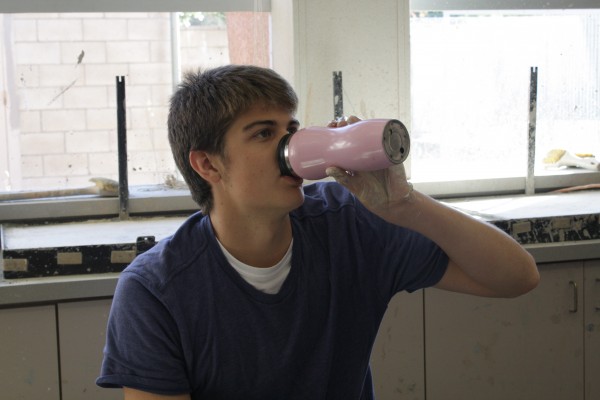
Maria Carrillo High School senior March Del Fava drinks coffee to combat drowsiness at school. Photo by Karrine Cusenza of the Puma Prensa
By KENNY KASPER,17, SENIOR, and MARIANNA MAPES, 18, SENIOR
MARIA CARRILLO HIGH SCHOOL
Marc Del Fava starts each day with a jolt — in the form of three cups of coffee. But the Maria Carrillo High School senior doesn’t stop there. He fills a pink thermos bottle with another two or three cups, which he sips throughout the morning.
“I drink it to function properly,” said Del Fava. “Coffee gets my system going.”
Caffeine, found in coffee, green tea and energy drinks, acts as a stimulant to the central nervous system, temporarily spiking blood pressure and creating a heightened sense of alertness. It also is a diuretic, increasing both the rate of urine excretion and the possibility of dehydration. Caffeine is most widely recognized in the form of coffee, often used by adults as a wake-up call to start the day. However, this habit has begun to infiltrate teen culture as well — a shift associated with the bustling schedule of the modern adolescent. Many teens start drinking coffee for an occasional morning pick-me-up, but the habit quickly becomes part of a daily routine.
“At first it was for trying to stay awake in the morning, so I could be alert . . . but then, I don’t know, it just became a daily activity,” said senior Estella Wong, who began drinking coffee on weekdays this school year.
It is no coincidence that she also started advanced placement chemistry — a class noted for its rigor and difficulty — at the same time.
Similar tales from other students, including senior Jeff Beasley, corroborate the link between regular caffeine consumption and reduced sleep.
In addition to a full course load that includes AP calculus, Beasley spends 15 hours a week doing gymnastics, so he clocks about six hours of sleep on weeknights. This school year, Beasley began drinking a mug of coffee each morning to shake off drowsiness. Beasley has noticed his mind is sharper in the mornings as a result.
“It helps a lot. The first couple classes are easier to pay attention in,” said Beasley.
According to pediatrician Ari Hauptman, some attention deficit disorder, or ADD, patients successfully use some form of caffeine to focus. However, this is not always the case, especially for those who do not suffer from a disorder. For some students, it has just the opposite effect.
“After I drink a lot of coffee, I get into this transcendent perception of reality where everything is happening at once but I can’t focus on anything,” Del Fava said.
Hauptman warns that habits like drinking coffee daily are linked to appetite suppression and can throw a diet out of balance because it is common to “have a lot of caffeine and then have more simple sugars or simple carbohydrates without a nice mix of complex carbohydrates, fat and protein.”
“If you have a cup of coffee, you might have a donut with it, whereas if you have a glass of milk, you might have a real breakfast . . . it’s not always the case, but often it is,” said Hauptman.
Junior Joanna Proctor, who began drinking coffee while taking AP chemistry last year, admits she does not usually eat a full breakfast with her morning cup of joe.
“It’s drink coffee, sprint out the door, get to school,” said Proctor, who takes several AP courses and spends more than 20 hours a week training a horse.
Del Fava also has seen his eating habits change because of caffeine consumption.
“I drink coffee on an empty stomach, and I recently noticed that I’ve developed a stutter,” he said.
WebMD, a health information website, reports that while mindful and moderate caffeine consumption provides a short-term energy boost, too much java leads to nervousness and interrupted sleep patterns. Caffeine also can make teens more prone to headaches and migraines, including the possibility of withdrawal symptoms if a regular drinker misses his fix. Conversely, teens are less prone to such conditions as acid reflux as a result of the caffeine.
In recent years, energy drinks have emerged on the beverage scene, although caffeine aficionados tend to drink coffee much more frequently. Neither Wong nor Proctor drinks energy drinks at all, and Beasley only does so from time to time.
However, energy drinks may have the most dangerous implications, as they have reportedly sent adolescents to hospital emergency rooms with irregular or fast heart rhythms, such as super ventricular tachycardia.
Hauptman said he saw a teen after a trip to the emergency room who had consumed three 5-Hour Energy shots in succession. While these heart rhythms are rarely life threatening, they can lead to heart failure, especially in individuals with pre-existing heart conditions.
A more widespread danger of the energy drink movement may be its links to risky behavior. While Hauptman does not believe energy drinks are a “gateway drug,” a New York Times article explored the Journal of American College Health’s reports of a connection between energy drinks and substance abuse. The study did not find drinking energy drinks caused such behavior, but it warned parents that children who consume energy drinks are more prone to reckless behavior.
Kaiser Permanente health educator Lynn Zimmerman advocates that patients look beyond the cup of joe when they need a boost.
“I would explore with the patient possible alternative food sources of energy, including adding fresh fruits and healthy snacks to increase energy,” said Zimmerman.
She also recommends increased physical activity to reduce stress and to promote a sense of well-being, but adds that a healthy lifestyle needn’t be entirely devoid of caffeine.
“Moderation is the key,” she said.
This article and photo were reprinted from Maria Carrillo High School’s newspaper, the Puma Prensa.
